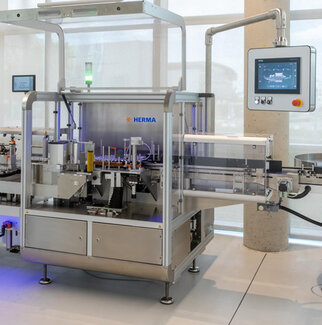Labelling 600 products per minute and at the same time printing variable data, without the need for additional printing consumables: The HERMA wrap-around labelling machine 132M HC for pharmaceutical and healthcare products makes this possible. At ACHEMA, HERMA will be presenting the labelling machine for the first time with a U510 UV laser from Domino (Hall 4.1, Stand B20). "Together with the new HERMA UV film labels, this represents the first step into a new labelling era," says Martin Kühl, Head of the Labelling Machines division. This is because for the first time the contactless and therefore extremely low-maintenance, fast and efficient lasers can be used to generate the printed image solely by changing the colour in the film label. And often it is only film labels that can meet the requirements of many pharmaceutical and healthcare products. This change in colour in the film material brought about by the UV laser results in an extremely high level of resistance, e.g. to disinfectants, alcohol and grease. Furthermore, the typeface is absolutely smudge-proof and scratch-resistant. "The integration of this laser printing module is a further element that underpins HERMA's comprehensive expertise in pharmaceutical applications," emphasizes Martin Kühl. Thanks to a well-conceived modular design with standardised assemblies, HERMA labelling machines also deliver consistently reproducible results. Labels with missing or illegible print or code are automatically rejected at the 132M HC; only confirmed labels are applied to the products. If a label is rejected, the starwheel stops briefly to ensure that every product receives a label. UV sensors then check that the labels are present on the products. In addition, automatic rejection of products without a label and double-checking to ensure that these products are indeed rejected ensures that only confirmed products leave the machine. Even the separation of products without a label onto a reject conveyor is performed extremely carefully and gently. Optionally, a reject station can also be integrated below the rotating starwheel. As the starwheel is now larger due to introduction of the new Clean Design concept, it is possible to integrate even more checking options. This may be of interest, for example, for vials where the colour or a data matrix code on the cap needs to be checked. Thanks to the Clean Design concept, the printer and camera panels are now also in a particularly favorable position from an ergonomic standpoint.
Broad range of applications, few format parts
Just as important for efficient operation is the new Human Machine Interface (HMI), which picks up on the clear and intuitive user control and symbol language that users of the HERMA 500 applicator are already familiar with. The applicator and labelling machine are thus characterized by a uniform operation mode. The realistic machine visualisation in the HMI also enables extremely reliable, targeted and unambiguous guidance of the operating personnel. The 132M HC is designed for products with a diameter of 14.75 millimeters to 110 millimeters, but manages with very few format parts, for example for the infeed and outfeed as well as for the starwheel. The few format parts fit on a single, clearly arranged and easily stowed plate.
Process reliability from the word go
However, equipment and configuration of the hardware is just one, albeit important, aspect for compliance with strict pharmaceutical requirements such as statutory regulations and GMP provisions. This is why an interdisciplinary pharmaceutical team comprising Sales, Internal Sales, Project Management and Service has long been active at HERMA. This team supports every customer project, from the enquiry and order phases through to the acceptance and installation phases. For example, a design review based on a detailed 3D model created by the engineering department takes place while the project is still in the order phase. On completion of the machine, project managers and technicians validate the machine at HERMA as part of the Factory Acceptance Test (FAT). HERMA specialists then install and set up the machine on the customer's premises and provide support for the Site Acceptance Test (SAT). To ensure smooth commissioning, the line throughput as well as the interfaces to other machines in the line are checked. Furthermore, experienced pharmaceutical experts are on hand throughout the life cycle and utilisation phase. They provide customers with support in optimising operation, carrying out performance-preserving maintenance and even upgrading existing systems cost-effectively to make them ready for new challenges, e.g. through retrofits. "At every point of each individual customer journey, customers therefore benefit from our specific know-how," Martin Kühl points out. "Process reliability starts from the word go, during planning and clean project implementation."

